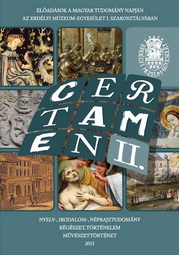Őraljaboldogfalva középkori templomának 1400 körüli falképei
The Murals Dating around 1400 from the Sântămărie-Orlea Calvinist Church
Author(s): Tekla SzabóSubject(s): Cultural history
Published by: Erdélyi Múzeum-Egyesület
Keywords: mural painting; 1400; Saint Elizabeth of Hungary; Holy Kings; Pauline order
Summary/Abstract: The present study is intended to provide a fresh analysis of the Gothic murals in the currently Protestant church of Sântămărie-Orlea. The church and especially its precious frescoes have raised the interest of many scholars, both Hungarian and Romanian scholars, but the poor state of conservation of the paintings allowed room for many different interpretations. A new reading of these frescoes is proposed here, based on a series of historic copies, until recently unknown, which provide the grounds to clear up some misinterpretations. Nevertheless, a certain degree of incertitude will remain for as long as these valuable paintings, dated around 1400, are not restored. The wall-paintings are placed inside the frames formed beneath the vaults supporting the western gallery. Generally we can say that they represent saints important to the royal court. South of the entrance we can see St. Elizabeth of Hungary, the first woman beatified from the Árpád Dynasty, who offered a new model of piety. North to the entrance we have a hardly interpretable mural with standing saints. The middle one is supposedly representing a Holy King. The scene placed on the northern wall with the inscription OBIT PAUPER PAULUS seems to be an original composition, most probably connected with the Pauline order, very close to the royal court, whose important achievement was the transportation of the corpse of St. Paul of Thebes (the order’s protector) in 1381 to the monastery from the Buda hills. The determination of the style and of the time when this mural was painted is hampered by the actual state of conservation of the frescoes. There is no doubt about that the mural is part of the international Gothic style fresco circle with elements from Trecento, dated around 1400. The restoration of the murals will surely bring out new information and even show completely new valences of the Transylvanian Art.
Journal: Certamen
- Issue Year: 2015
- Issue No: II
- Page Range: 328-346
- Page Count: 19
- Language: Hungarian

